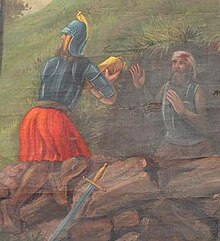This article uses texts from within a religion or faith system without referring to secondary sources that critically analyze them. (November 2010) |
Mormon | |
|---|---|
 Moroni Receives the Plates from Mormon, by C. C. A. Christensen (c. 1871–1875) | |
| Personal | |
| Children | Moroni (son) |
| Parent |
|
| Notable work(s) |
|
| Relatives | Nephi (ancestor) Lehi (ancestor) |
Mormon /ˈmɔːrmən/ is believed by members of the Church of Jesus Christ of Latter-day Saints to be a prophet-historian and a member of a tribe of indigenous Americans known as the Nephites, one of the four groups (including the Lamanites, Jaredites, and Mulekites) described in the Book of Mormon as having settled in the ancient Americas.
According to the Book of Mormon, the prophet Mormon engraved an abridgement of his people's history on golden plates. Based on the chronology described in the book, Mormon lived during the 4th century AD. As a narrator in the text, Mormon presents himself as a redactor. He quotes and paraphrases other writers, collects and includes whole texts by other authors, contributes running commentary, and also writes his own narrative. He writes about the process of making the book, both in terms of compiling the works of other prophets and also in terms of engraving the words on metal plates. He alludes to content that is left out of the book, and refers to a larger collection of records at his disposal.
The Book of Mormon states that Mormon was instructed by the prophet Ammaron where to find the records that had been passed down from their ancestors. It also says that Mormon later abridged the near-millennium-long history of his ancestors, and added additional revelations into the Book of Mormon. Divisions of the book relating to Mormon's personal history are the Words of Mormon and the first seven chapters of the larger book. The book says that Mormon eventually passed all of the records on to his son Moroni.